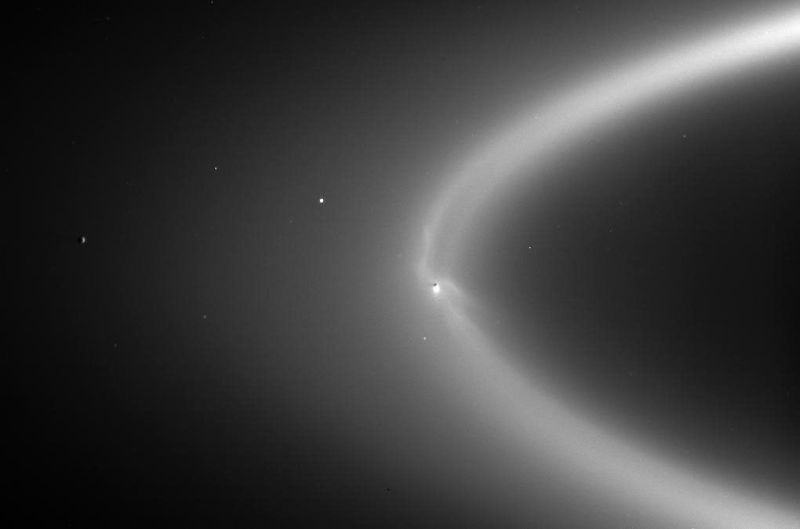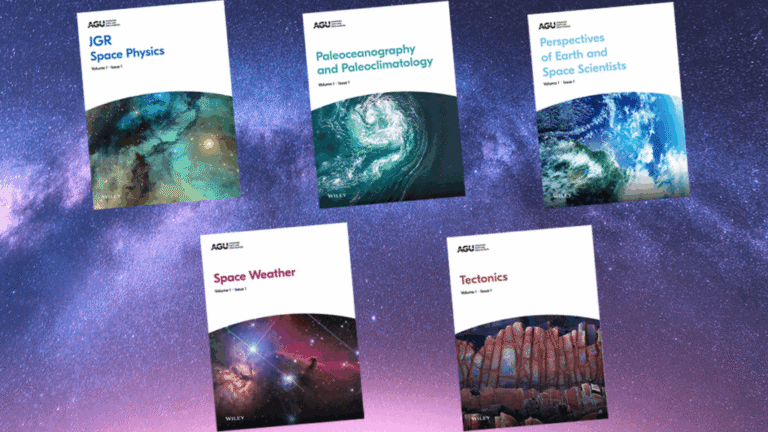

In 2008, NASA’s now-departed Cassini spacecraft made its fastest flyby of Enceladus, the moon of Saturn that’s spewing its subsurface ocean into space. A new analysis of data from that flyby has revealed a bevy of complex organic compounds that hadn’t been detected before and confirmed the origin of several previously known organics. The speed at which the flyby occurred, a zippy 18 kilometers per second, helped convince the researchers that the organics truly originated from Enceladus’s interior ocean and were not a product of postejection space weathering.
When combined with the slate of previously detected organic compounds, “these new organics could support chemical networks or chemical pathways that potentially could lead to biologically relevant compounds,” said Nozair Khawaja, lead researcher on this discovery and a planetary scientist at Freie Universität Berlin in Germany.
Connecting Chemistries
Enceladus emits plumes of water from its subsurface ocean through icy cracks near its south pole. Enough material has been released into space to create a ring around Saturn called the E ring. During its 13 years exploring the Saturn system, Cassini collected and analyzed multiple samples from the E ring and discovered a wide variety of organic and inorganic molecules, including aromatics and oxygen-bearing species, that hinted at complex chemistry happening within Enceladus.
“If you capture some particles in the E ring, that means, indirectly, you are sampling the subsurface ocean.”
“If you capture some particles in the E ring, that means, indirectly, you are sampling the subsurface ocean,” Khawaja said.
However, planetary scientists have debated whether all of the organic compounds discovered in E ring material could truly be traced back to the Enceladean ocean. After all, material sits in the E ring for years, and the material’s chemistry may have been altered through exposure to radiation from Saturn and the solar system, a process called space weathering.

But Cassini didn’t just fly through Saturn’s rings. It also flew directly through Enceladus’s plumes. During those flybys, the spacecraft’s onboard Cosmic Dust Analyzer (CDA) collected and measured spectra from freshly ejected material. Grains of material entered the CDA collector and shattered into chemical constituents—mostly water ice with smatterings of other molecules. The CDA measured chemical spectra and reported what those grains were made of.
The trouble is that water molecules are very sticky, Khawaja explained. After shattering, ice molecules quickly cluster around and shield other molecules from detection. The slower the grains traveled through the instrument, the less time CDA had to spot those other compounds, which were the ones that scientists were most interested in decoding.
Previous analyses of Enceladus and E ring flybys, most of which occurred at relative speeds less than 12 kilometers per second, detected five of the six elements essential for Earth’s biology—the CHNOPS elements—but other materials remained elusive.
Speed Is Everything
Luckily, Cassini’s fifth Enceladus flyby was particularly speedy. Plume material traveled through the CDA at 18 kilometers per second. Analysis of data from that flyby, conducted by Khawaja and his team, revealed that the freshly ejected ice grains contained many of the same compounds that had previously been found in E ring material.

“These new particles, they were very young in age and very fresh material,” Khawaja said. “That means, if we observe in these fresh grains the same compounds [seen] in the E ring grains, which are months or many years old, that means that those compounds are actually coming from the subsurface of Enceladus.”
Because the material collected in this flyby did not have time to be altered by space radiation, these chemical commonalities “effectively rule out” space radiation or another process external to Enceladus as the source of complex organic material in the E ring and Enceladus’s ocean, explained Alexander Berne.
The results “indicate that endogenic processes, such as hydrothermal activity, i.e., energy-releasing interactions between silicate rock and water, form the observed chemistry,” Berne said. “This hydrothermal activity is potentially a key process for sustaining metabolic reactions to support astrobiology within Enceladus,” like black smokers near Earth’s mid-ocean ridges. Berne, a planetary scientist at the California Institute of Technology in Pasadena, was not involved with this research.
New Ingredients in the Soup
The swiftness of this particular flyby also enabled the CDA to measure the spectra of several previously undetected complex organic compounds before they were shielded behind an icy curtain. These compounds, including oxygen- and nitrogen-bearing species, aryls, alkenes, and ethyls, strengthen the theory that they were generated through geochemical processes at the base of the Enceladean ocean.
“The new compounds confirm that organics are present in the subsurface ocean and may indicate more complex, potentially hydrothermal processes there,” said Larry Esposito, a planetary scientist at the University of Colorado Boulder who was not involved with this research. “The new findings are consistent with the likely habitability of the ocean, which may resemble a complex organic ‘primordial soup.’”
These results were published in Nature Astronomy in October.
Khawaja cautioned that these newly detected organics do not mean that life exists in Enceladus’s ocean or that life is an inevitable result of mixing together this primordial soup. Continued analysis of archival Cassini data, bolstered by future laboratory experiments, could reveal the many potential outcomes of this chemical mixture and could piece together its origin story.
—Kimberly M. S. Cartier (@astrokimcartier.bsky.social), Staff Writer
Citation: Cartier, K. M. S. (2025), Speedy flyby adds new organics to Enceladus’s “primordial soup,” Eos, 106, https://doi.org/10.1029/2025EO250416. Published on 12 November 2025.
Text © 2025. AGU. CC BY-NC-ND 3.0
Except where otherwise noted, images are subject to copyright. Any reuse without express permission from the copyright owner is prohibited.


